The Analysis of Spatial Patterns and Significant Factors Associated with Young-Driver-Involved Crashes in Florida
Abstract
:1. Introduction
2. Literature Review
2.1. Youth Population Involvement in Crashes
2.2. Geospatial Crash Analysis
2.3. Statistical Analysis of Correlated Factors
3. Methodology
4. Study Area and Data Description
5. Results
5.1. GIS-Based Visual Illustrations
5.2. Regression Analysis
6. Conclusions and Practical Applications
7. Limitations and Future Work
Author Contributions
Funding
Institutional Review Board Statement
Informed Consent Statement
Data Availability Statement
Acknowledgments
Conflicts of Interest
References
- WHO. WHO Global Status Report on Road Saf. 2013: Supporting a Decade of Action; WHO: Geneva, Switzerland, 2013. [Google Scholar]
- Alam, B.M.; Spainhour, L. Logit and Case-Based Analysis of Drivers’ Age as a Contributing Factor for Fatal Traffic Crashes on Highways and State Roads in Florida. In Proceedings of the Transportation Research Board 93th Annual Meeting, Washington, DC, USA, 15 January 2014. [Google Scholar]
- Buckley, L.; Chapman, R.L.; Sheehan, M. Young Driver Distraction: State of the Evidence and Directions for Behavior Change Programs. J. Adolesc. Heal. 2014, 54, S16–S21. [Google Scholar] [CrossRef] [PubMed] [Green Version]
- European Union. Road Saf. in the European Union—Trends, Statistics and Main Challenges; European Commission: Brussel, Belgium, 2018. [Google Scholar] [CrossRef]
- Clarke, D.D.; Ward, P.; Truman, W. Voluntary risk taking and skill deficits in young driver accidents in the UK. Accid. Anal. Prev. 2005, 37, 523–529. [Google Scholar] [CrossRef] [PubMed]
- Dezman, Z.; de Andrade, L.; Vissoci, J.R.; El-Gabri, D.; Johnson, A.; Hirshon, J.M.; Staton, C.A. Hotspots and causes of motor vehicle crashes in Baltimore, Maryland: A geospatial analysis of five years of police crash and census data. Injury 2016, 47, 2450–2458. [Google Scholar] [CrossRef] [PubMed] [Green Version]
- Wells, P.; Tong, S.; Sexton, B.; Grayson, G.; Jones, E. Cohort II: A Study of Learner and New Drivers/Volume 1, Main Report. 2008. Available online: https://trid.trb.org/view/1153843 (accessed on 23 October 2021).
- Cassarino, M.; Murphy, G. Reducing young drivers’ crash risk: Are we there yet? An ecological systems-based review of the last decade of research. Transp. Res. Part F Traffic Psychol. Behav. 2018, 56, 54–73. [Google Scholar] [CrossRef]
- Bagloee, S.A.; Asadi, M. Crash analysis at intersections in the CBD: A survival analysis model. Transp. Res. Part A Policy Pract. 2016, 94, 558–572. [Google Scholar] [CrossRef]
- Kidando, E.; Kitali, A.E.; Kutela, B.; Ghorbanzadeh, M.; Karaer, A.; Koloushani, M.; Moses, R.; Ozguven, E.E.; Sando, T. Prediction of vehicle occupants injury at signalized intersections using real-time traffic and signal data. Accid. Anal. Prev. 2021, 149, 105869. [Google Scholar] [CrossRef] [PubMed]
- Hasan, M.K.; Younos, T.B. Safety culture among Bangladeshi university students: A cross-sectional survey. Saf. Sci. 2020, 131, 104922. [Google Scholar] [CrossRef]
- Ball, K.; Owsley, C.; Stalvey, B.; Roenker, D.L.; Sloane, M.E.; Graves, M. Driving avoidance and functional impairment in older drivers. Accid. Anal. Prev. 1998, 30, 313–322. [Google Scholar] [CrossRef]
- Vemulapalli, S.S.; Ulak, M.B.; Ozguven, E.E.; Sando, T.; Horner, M.W.; Abdelrazig, Y.; Moses, R. GIS-based Spatial and Temporal Analysis of Aging-Involved Accidents: A Case Study of Three Counties in Florida. Appl. Spat. Anal. Policy 2017, 10, 537–563. [Google Scholar] [CrossRef]
- Huang, H.; Abdel-Aty, M.A.; Darwiche, A.L. County-Level Crash Risk Analysis in Florida: Bayesian Spatial Modeling. Transp. Res. Rec. J. Transp. Res. Board 2010, 2148, 27–37. [Google Scholar] [CrossRef]
- Koloushani, M.; Ghorbanzadeh, M.; Ozguven, E.E.; Ulak, M.B. Crash Patterns in the COVID-19 Pandemic: The Tale of Four Florida Counties. Futur. Transp. 2021, 1, 414–442. [Google Scholar] [CrossRef]
- United States Census Bureau. The Encyclopedia of Housing, 2019. Available online: https://www.census.gov/quickfacts/fact/table/alachuacountyflorida,duvalcountyflorida,leoncountyflorida/POP010210 (accessed on 23 October 2021).
- Centers for Disease Control and Prevention (CDC). Underlying Cause of Death 1999–2019—National Center for Health Statistics. 2019. Available online: https://wonder.cdc.gov/ucd-icd10.html (accessed on 23 October 2021).
- Schneider, R.J.; Khattak, A.J.; Zegeer, C.V. Method of Improving Pedestrian Safety Proactively with Geographic Information Systems: Example from a College Campus. Transp. Res. Rec. J. Transp. Res. Board 2001, 1773, 97–107. [Google Scholar] [CrossRef]
- Loukaitou-Sideris, A.; Medury, A.; Fink, C.; Grembek, O.; Shafizadeh, K.; Wong, N.; Orrick, P. Crashes on and Near College Campuses: A Comparative Analysis of Pedestrian and Bicyclist Safety. J. Am. Plan. Assoc. 2014, 80, 198–217. [Google Scholar] [CrossRef]
- Nickkar, A.; Banerjee, S.; Chavis, C.; Bhuyan, I.A.; Barnes, P. A spatial-temporal gender and land use analysis of bikeshare ridership: The case study of Baltimore City. City Cult. Soc. 2019, 18, 100291. [Google Scholar] [CrossRef]
- Bridgelall, R. Campus parking supply impacts on transportation mode choice. Transp. Plan. Technol. 2014, 37, 711–737. [Google Scholar] [CrossRef] [Green Version]
- Nash, S.; Mitra, R. University students’ transportation patterns, and the role of neighbourhood types and attitudes. J. Transp. Geogr. 2019, 76, 200–211. [Google Scholar] [CrossRef]
- Harbeck, E.L.; Glendon, A.I. Driver prototypes and behavioral willingness: Young driver risk perception and reported engagement in risky driving. J. Saf. Res. 2018, 66, 195–204. [Google Scholar] [CrossRef] [PubMed]
- Laflamme, L.; Hasselberg, M.; Kullgren, A.; Vaez, M. First car-to-car crashes involving young adult drivers: Main patterns and their relation to car and driver characteristics. Int. J. Inj. Contr. Saf. Promot. 2006, 13, 179–186. [Google Scholar] [CrossRef]
- Fergusson, D.; Swain-Campbell, N.; Horwood, J. Risky driving behaviour in young people: Prevalence, personal characteristics and traffic accidents. Aust. N. Z. J. Public Health 2003, 27, 337–342. [Google Scholar] [CrossRef]
- Jeihani, M.; Ahangari, S.; Pour, A.H.; Khadem, N.; Banerjee, S. Investigating the Impact of Distracted Driving among Different Socio-Demographic Groups; Urban Mobility & Equity Center: Baltimore, MD, USA, 2019; Available online: https://trid.trb.org/view/1674314 (accessed on 23 October 2021).
- Hassan, H.M.; Abdel-Aty, M.A. Exploring the safety implications of young drivers’ behavior, attitudes and perceptions. Accid. Anal. Prev. 2013, 50, 361–370. [Google Scholar] [CrossRef]
- Kidando, E.; Kitali, A.E.; Kutela, B.; Karaer, A.; Ghorbanzadeh, M.; Koloushani, M.; Ozguven, E.E. Use of Real-Time Traffic and Signal Timing Data in Modeling Occupant Injury Severity at Signalized Intersections. Transp. Res. Rec. J. Transp. Res. Board 2021, 036119812110478. [Google Scholar] [CrossRef]
- Miller, L.; Walshe, E.; McIntosh, C.; Romer, D.; Winston, F. “What were they thinking?”: Metacognition and impulsivity play a role in young driver risk-taking. J. Psychiatry Behav. Sci. 2021, 4, 1048. [Google Scholar]
- Deery, H.A. Hazard and Risk Perception among Young Novice Drivers. J. Saf. Res. 1999, 30, 225–236. [Google Scholar] [CrossRef]
- Preece, C.; Watson, A.; Kaye, S.-A.; Fleiter, J. Understanding the psychological precursors of young drivers’ willingness to speed and text while driving. Accid. Anal. Prev. 2018, 117, 196–204. [Google Scholar] [CrossRef] [PubMed]
- Nasr Esfahani, H.; Arvin, R.; Song, Z.; Sze, N.N. Prevalence of cell phone use while driving and its impact on driving performance, focusing on near-crash risk: A survey study in Tehran. J. Transp. Saf. Secur. 2021, 13, 957–977. [Google Scholar] [CrossRef]
- Evans, L.; Wasielewski, P. Risky driving related to driver and vehicle characteristics. Accid. Anal. Prev. 1983, 15, 121–136. [Google Scholar] [CrossRef]
- Rahman, M.A.; Hossain, M.M.; Mitran, E.; Sun, X. Understanding the contributing factors to young driver crashes: A comparison of crash profiles of three age groups. Transp. Eng. 2021, 5, 100076. [Google Scholar] [CrossRef]
- Clarke, D.D.; Ward, P.; Bartle, C.; Truman, W. Killer crashes: Fatal road traffic accidents in the UK. Accid. Anal. Prev. 2010, 42, 764–770. [Google Scholar] [CrossRef]
- Gheorghiu, A.; Delhomme, P.; Felonneau, M.L. Peer pressure and risk taking in young drivers’ speeding behavior. Transp. Res. Part F Traffic Psychol. Behav. 2015, 35, 101–111. [Google Scholar] [CrossRef]
- Yannis, G.; Laiou, A.; Papantoniou, P.; Christoforou, C. Impact of texting on young drivers’ behavior and safety on urban and rural roads through a simulation experiment. J. Saf. Res. 2014, 49, 25.e1-31. [Google Scholar] [CrossRef]
- Atchley, P.; Atwood, S.; Boulton, A. The choice to text and drive in younger drivers: Behavior may shape attitude. Accid. Anal. Prev. 2011, 43, 134–142. [Google Scholar] [CrossRef] [PubMed]
- Rolison, J.J.; Moutari, S. Combinations of factors contribute to young driver crashes. J. Saf. Res. 2020, 73, 171–177. [Google Scholar] [CrossRef] [PubMed]
- Islam, M.A.; Singh, P. Intersection Related Crash Injuries: A Study on Factors Contributing to Injury Severity among Younger and Older Drivers in Summer and Winter. J. Transp. Technol. 2020, 10, 364–379. [Google Scholar] [CrossRef]
- Yao, S.; Loo, B.P.Y.; Yang, B.Z. Traffic collisions in space: Four decades of advancement in applied GIS. Ann. GIS 2016, 22, 1–14. [Google Scholar] [CrossRef]
- Mousavi, S.M.; Zhang, Z.; Parr, S.A.; Pande, A.; Wolshon, B. Identifying High Crash Risk Highway Segments Using Jerk-Cluster Analysis. In Proceedings of the International Conference on Transportation and Development, Alexandria, VA, USA, 9–12 June 2019; American Society of Civil Engineers: Reston, VA, USA, 2019; pp. 112–123. [Google Scholar]
- Manap, N.; Borhan, M.; Muhamad, M.Y.; Hambali, M.; Rohan, A. Determining Spatial Patterns of Road Accidents at Expressway by Applying Getis-Ord Gi* Spatial Statistic. Int. J. Recent Technol. Eng. 2019, 8, 345–350. [Google Scholar] [CrossRef]
- Weiss, H.B.; Kaplan, S.; Prato, C.G. Fatal and serious road crashes involving young New Zealand drivers: A latent class clustering approach. Int. J. Inj. Contr. Saf. Promot. 2016, 23, 427–443. [Google Scholar] [CrossRef] [PubMed]
- Prasannakumar, V.; Vijith, H.; Charutha, R.; Geetha, N. Spatio-Temporal Clustering of Road Accidents: GIS Based Analysis and Assessment. Procedia Soc. Behav. Sci. 2011, 21, 317–325. [Google Scholar] [CrossRef] [Green Version]
- Okabe, A.; Okunuki, K.; Shiode, S. SANET: A Toolbox for Spatial Analysis on a Network. Geogr. Anal. 2006, 38, 57–66. [Google Scholar] [CrossRef]
- Okabe, A.; Sugihara, K. Spatial Analysis along Networks: Statistical and Computational Methods; John Wiley & Sons, Ltd.: Chichester, UK, 2012; ISBN 9781119967101. [Google Scholar]
- Ulak, M.B.; Ozguven, E.E.; Spainhour, L.; Vanli, O.A. Spatial investigation of aging-involved crashes: A GIS-based case study in Northwest Florida. J. Transp. Geogr. 2017, 58, 71–91. [Google Scholar] [CrossRef]
- Lord, D.; Mannering, F. The statistical analysis of crash-frequency data: A review and assessment of methodological alternatives. Transp. Res. Part A Policy Pract. 2010, 44, 291–305. [Google Scholar] [CrossRef] [Green Version]
- Mannering, F.L.; Bhat, C.R. Analytic methods in accident research: Methodological frontier and future directions. Anal. Methods Accid. Res. 2014, 1, 1–22. [Google Scholar] [CrossRef]
- Abdel-Aty, M.A.; Abdelwahab, H.T. Exploring the relationship between alcohol and the driver characteristics in motor vehicle accidents. Accid. Anal. Prev. 2000, 32, 473–482. [Google Scholar] [CrossRef]
- Kong, C.; Yang, J. Logistic regression analysis of pedestrian casualty risk in passenger vehicle collisions in China. Accid. Anal. Prev. 2010, 42, 987–993. [Google Scholar] [CrossRef] [PubMed]
- Fitzpatrick, C.D.; Rakasi, S.; Knodler, M.A. An investigation of the speeding-related crash designation through crash narrative reviews sampled via logistic regression. Accid. Anal. Prev. 2017, 98, 57–63. [Google Scholar] [CrossRef] [PubMed]
- Shirani, N.; Doustmohammadi, M.; Haleem, K.; Anderson, M. Safety Investigation of Nonmotorized Crashes in the City of Huntsville, Alabama, Using Count Regression Models. In Proceedings of the Transportation Research Board 97th Annual Meeting, Washington, DC, USA, 5–7 December 2018; Available online: https://trid.trb.org/view/1495585 (accessed on 23 October 2021).
- Karacasu, M.; Ergül, B.; Altin Yavuz, A. Estimating the causes of traffic accidents using logistic regression and discriminant analysis. Int. J. Inj. Contr. Saf. Promot. 2014, 21, 305–313. [Google Scholar] [CrossRef] [PubMed]
- Ye, F.; Lord, D. Comparing three commonly used crash severity models on sample size requirements: Multinomial logit, ordered probit and mixed logit models. Anal. Methods Accid. Res. 2014, 1, 72–85. [Google Scholar] [CrossRef] [Green Version]
- Se, C.; Champahom, T.; Jomnonkwao, S.; Banyong, C.; Sukontasukkul, P.; Ratanavaraha, V. Hierarchical binary logit model to compare driver injury severity in single-vehicle crash based on age-groups. Int. J. Inj. Contr. Saf. Promot. 2021, 28, 113–126. [Google Scholar] [CrossRef] [PubMed]
- Xie, Z.; Yan, J. Detecting traffic accident clusters with network kernel density estimation and local spatial statistics: An integrated approach. J. Transp. Geogr. 2013, 31, 64–71. [Google Scholar] [CrossRef]
- Plug, C.; Xia, J.; Caulfield, C. Spatial and temporal visualisation techniques for crash analysis. Accid. Anal. Prev. 2011, 43, 1937–1946. [Google Scholar] [CrossRef]
- Okabe, A.; Satoh, T.; Sugihara, K. A kernel density estimation method for networks, its computational method and a GIS-based tool. Int. J. Geogr. Inf. Sci. 2009, 23, 7–32. [Google Scholar] [CrossRef]
- James, G.; Witten, D.; Hastie, T.; Tibshirani, R. An Introduction to Statistical Learning: With Applications in R; Springer: New York, NY, USA, 2013. [Google Scholar]
- Florida Highway Safety and Motor Vehicles (FLHSMV) Licensing Requirements for Teens, Graduated Driver License Laws and Driving Curfews. Available online: https://www.flhsmv.gov/driver-licenses-id-cards/licensing-requirements-teens-graduated-driver-license-laws-driving-curfews/ (accessed on 23 October 2021).
- National Center for Education Statistics. College Navigator. 2021. Available online: https://nces.ed.gov/collegenavigator/ (accessed on 23 October 2021).
- Florida Department of Transportation (FDOT). Unified Basemap Repository. Available online: https://ubr.fdot.gov/basemaps/category/52 (accessed on 23 October 2021).
- US Geological Survey. College and University Information. 2018. Available online: https://www.usgs.gov/ (accessed on 23 October 2021).
- Ulak, M.B.; Kocatepe, A.; Ozguven, E.E.; Horner, M.W. How far from home do crashes occur? A network based analysis. Saf. Sci. 2019, 118, 298–308. [Google Scholar] [CrossRef]
- Wang, X.; Abdel-Aty, M.; Brady, P.A. Crash Estimation at Signalized Intersections. Transp. Res. Rec. J. Transp. Res. Board 2006, 1953, 10–20. [Google Scholar] [CrossRef]
- Kidando, E.; Moses, R.; Ghorbanzadeh, M.; Ozguven, E.E. Traffic Operation and Safety Analysis on an Arterial Highway: Implications for Connected Vehicle Applications. In Proceedings of the 2018 21st International Conference on Intelligent Transportation Systems (ITSC), Maui, HI, USA, 4–7 November 2018; IEEE: Piscataway, NJ, USA, 2018; pp. 2753–2758. [Google Scholar] [CrossRef]
- Hojjati-emami, K.; Dhillon, B.S.; Jenab, K. Stochastic Risk Assessment Methodology and Modeling as an In-Vehicle Safety Enhancing Tool for Younger Drivers on Roads. J. Transp. Saf. Secur. 2014, 6, 301–320. [Google Scholar] [CrossRef]
- Mahdavian, A.; Shojaei, A.; Mccormick, S.; Papandreou, T.; Eluru, N.; Oloufa, A.A. Drivers and Barriers to Implementation of Connected, Automated, Shared, and Electric Vehicles: An Agenda for Future Research. IEEE Access 2021, 9, 22195–22213. [Google Scholar] [CrossRef]
- Koloushani, M.; Fatemi, A.; Tabibi, M. Application of Global Positioning System Data Collected by Mobile Mapping System for Automatic Control of Safety Standards in Horizontal Curves. In Proceedings of the Transportation Research Board 93rd Annual Meeting, Washington, DC, USA, 15 January 2014; Available online: https://trid.trb.org/view/1287757 (accessed on 23 October 2021).
- Koloushani, M.; Ozguven, E.E.; Fatemi, A.; Tabibi, M. Mobile Mapping System-based Methodology to Perform Automated Road Safety Audits to Improve Horizontal Curve Safety on Rural Roadways. Comput. Res. Prog. Appl. Sci. Eng. 2020, 6, 263–275. [Google Scholar]
- Wang, L.; Zhong, H.; Ma, W.; Abdel-Aty, M.; Park, J. How many crashes can connected vehicle and automated vehicle technologies prevent: A meta-analysis. Accid. Anal. Prev. 2020, 136, 105299. [Google Scholar] [CrossRef] [PubMed]
- Yue, L.; Abdel-Aty, M.; Wu, Y.; Wang, L. Assessment of the safety benefits of vehicles’ advanced driver assistance, connectivity and low level automation systems. Accid. Anal. Prev. 2018, 117, 55–64. [Google Scholar] [CrossRef]
- Holmes, D.; Gabler, H.; Sherony, R. Estimating Benefits of LDW Systems Applied to Cross-Centerline Crashes. SAE Tech. Pap. 2018. [Google Scholar] [CrossRef]
- Koloushani, M.; Karaer, A.; Ozguven, E.E.; Sando, T.; Dulebenets, M.A.; Moses, R. Assessing the Spatial Correlation between Land Use and Injury Severity of Pedestrian-Involved Crashes that Do Not Occur at Intersections: A Network-Based Case Study in Northwest Florida. In Proceedings of the Transportation Research Board 101st Annual Meeting Transportation Research Board, Washington, DC, USA, 9–13 January 2022. [Google Scholar]
- Khoda Bakhshi, A.; Ahmed, M.M. Practical advantage of crossed random intercepts under Bayesian hierarchical modeling to tackle unobserved heterogeneity in clustering critical versus non-critical crashes. Accid. Anal. Prev. 2021, 149, 105855. [Google Scholar] [CrossRef]
- Jones, S.J.; Begg, D.J.; Palmer, S.R. Reducing young driver crash casualties in Great Britain—Use of routine police crash data to estimate the potential benefits of graduated driver licensing. Int. J. Inj. Contr. Saf. Promot. 2013, 20, 321–330. [Google Scholar] [CrossRef]
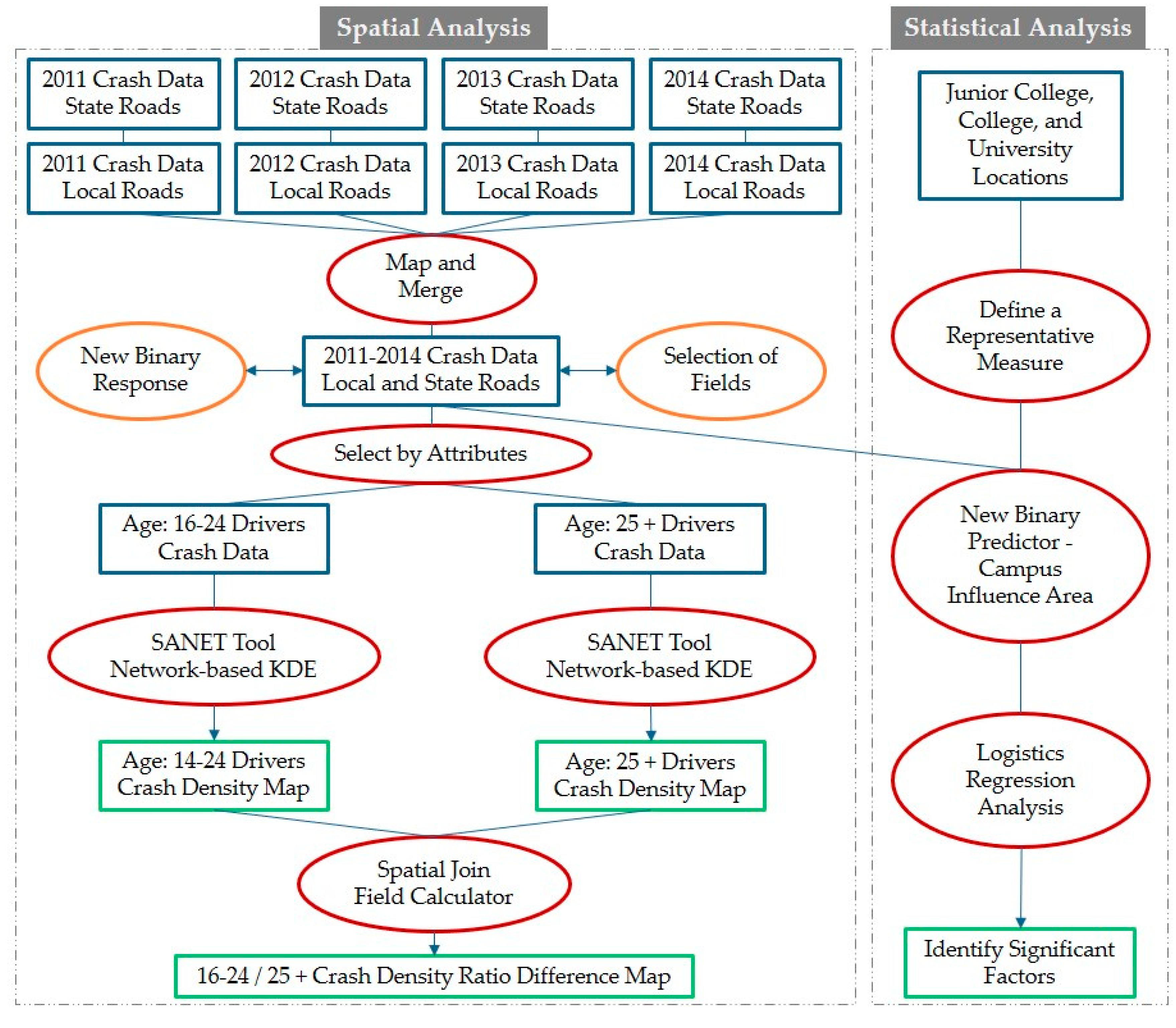
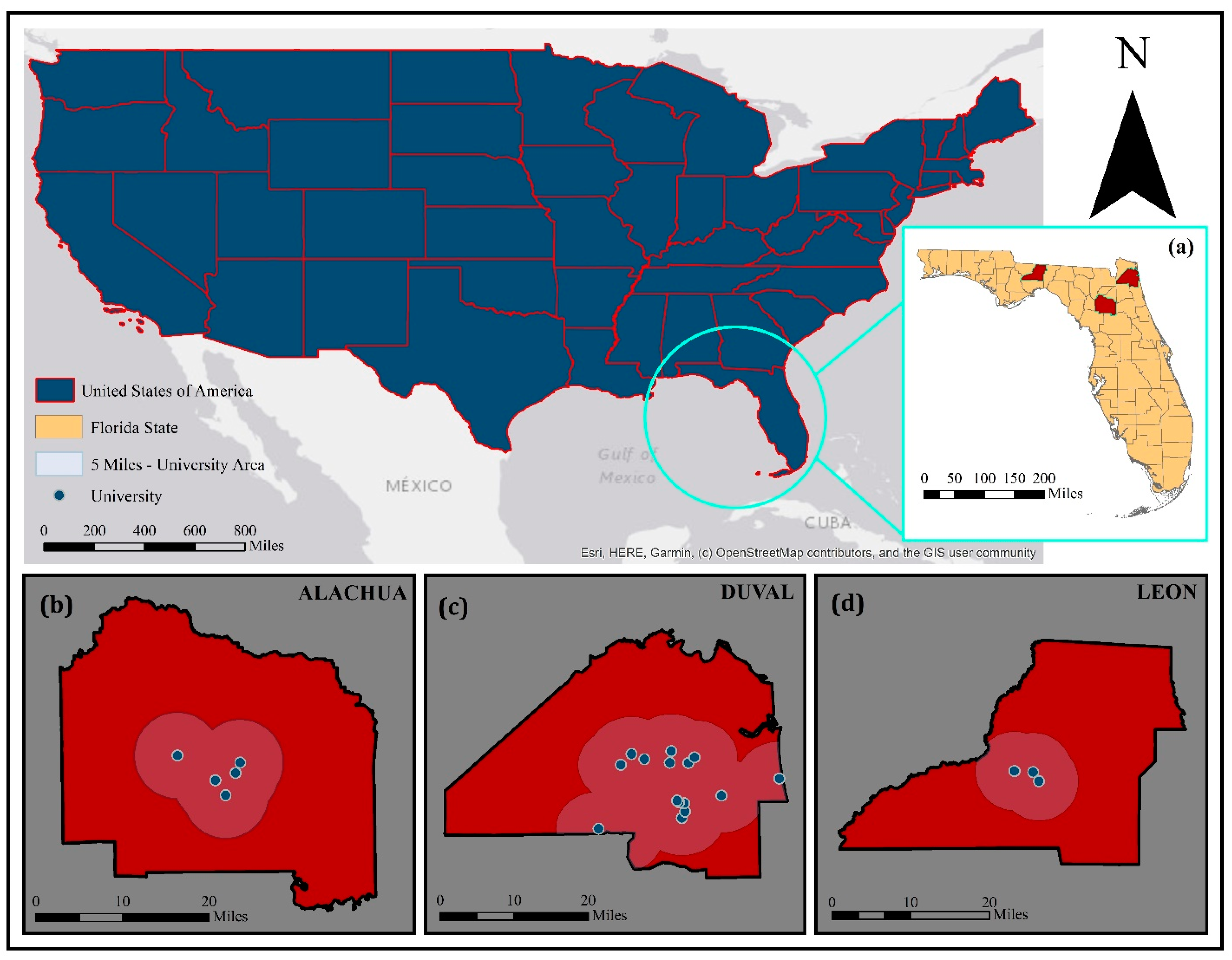
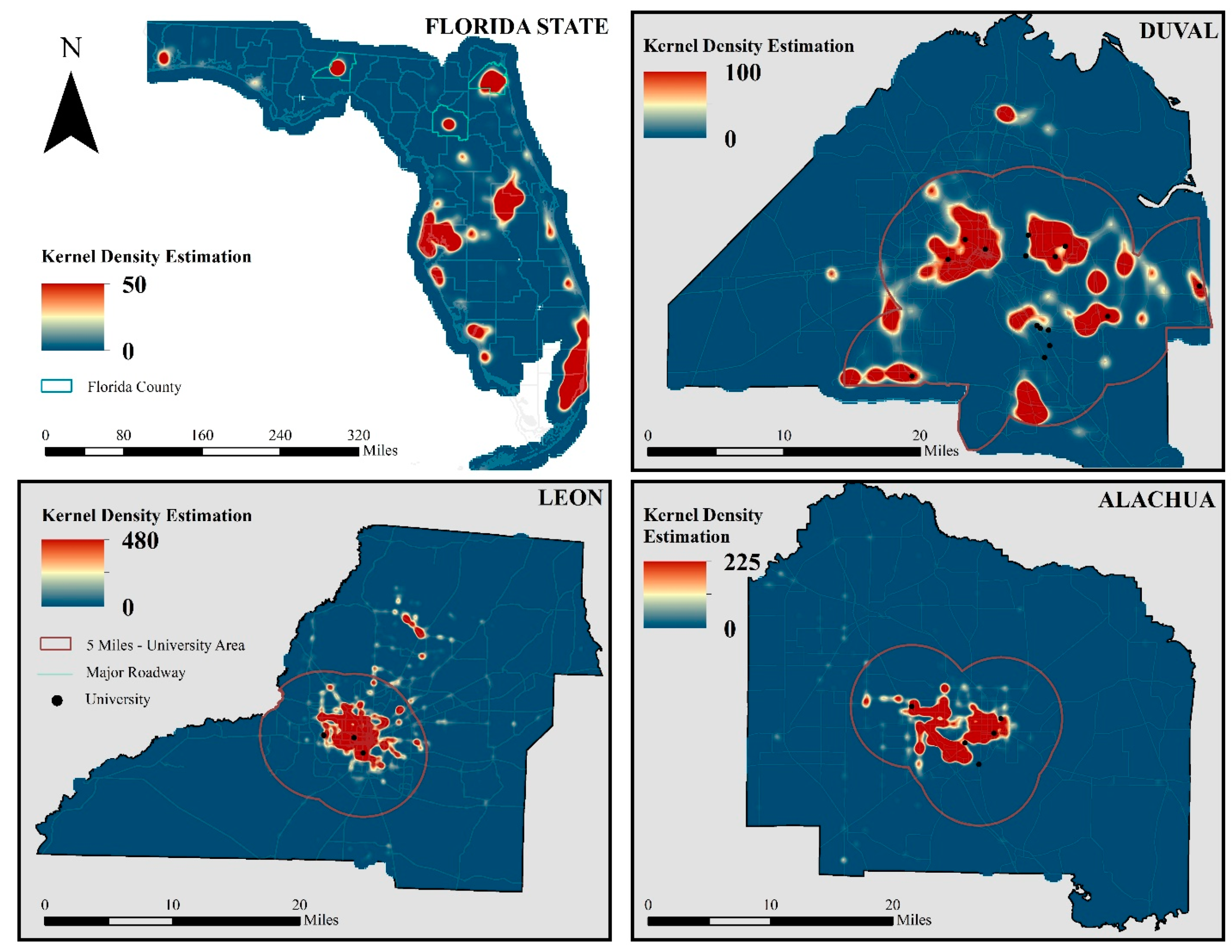
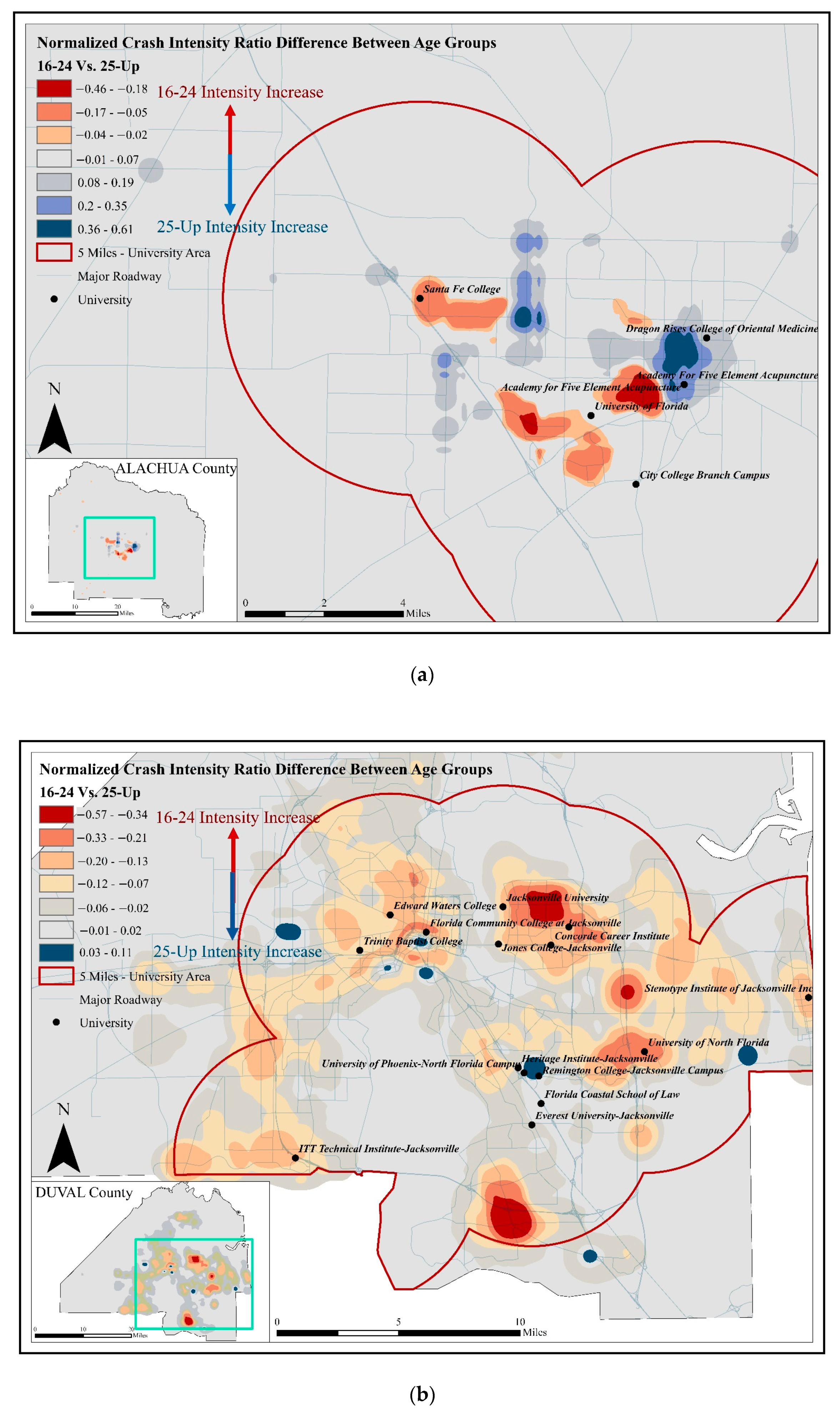
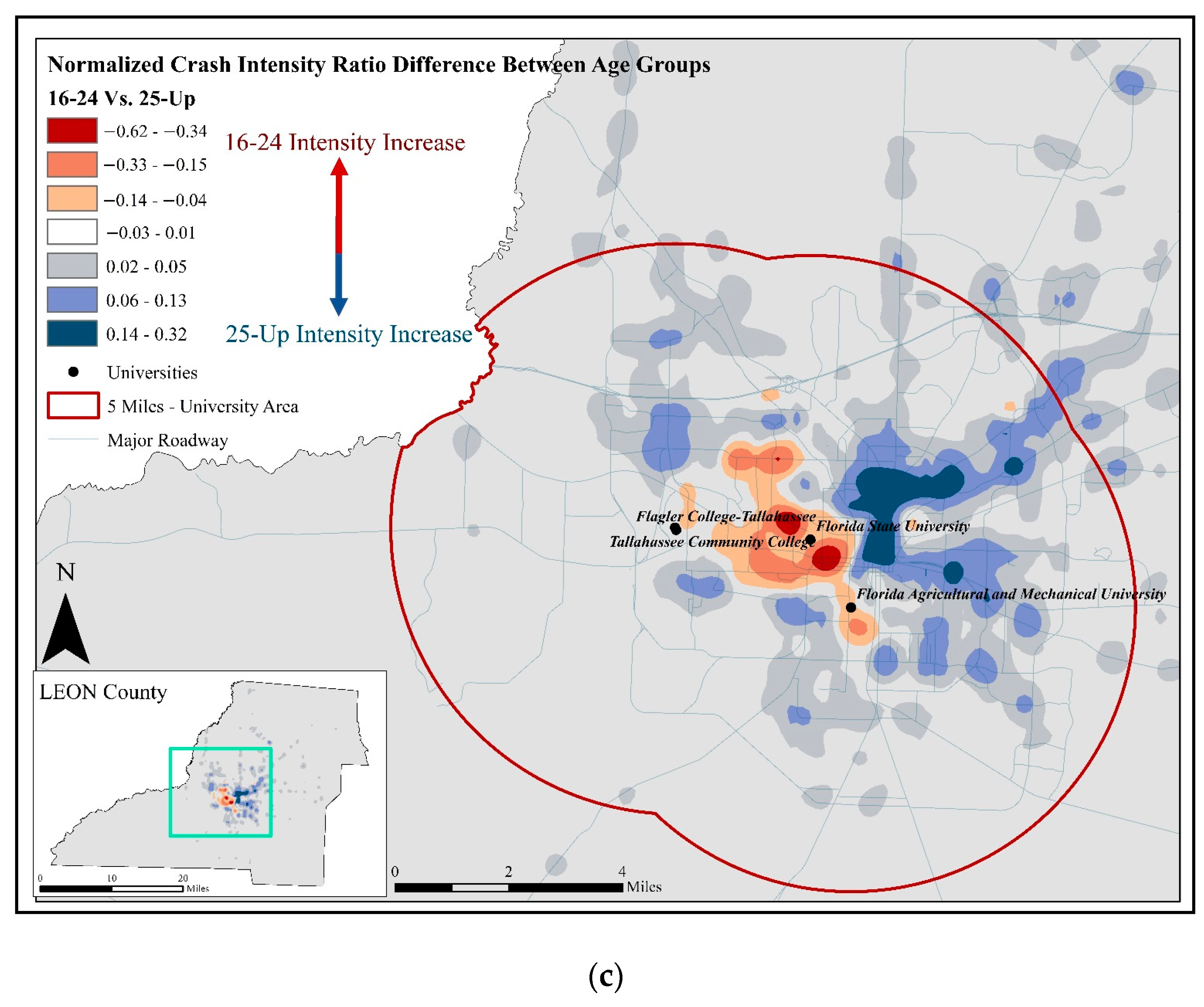
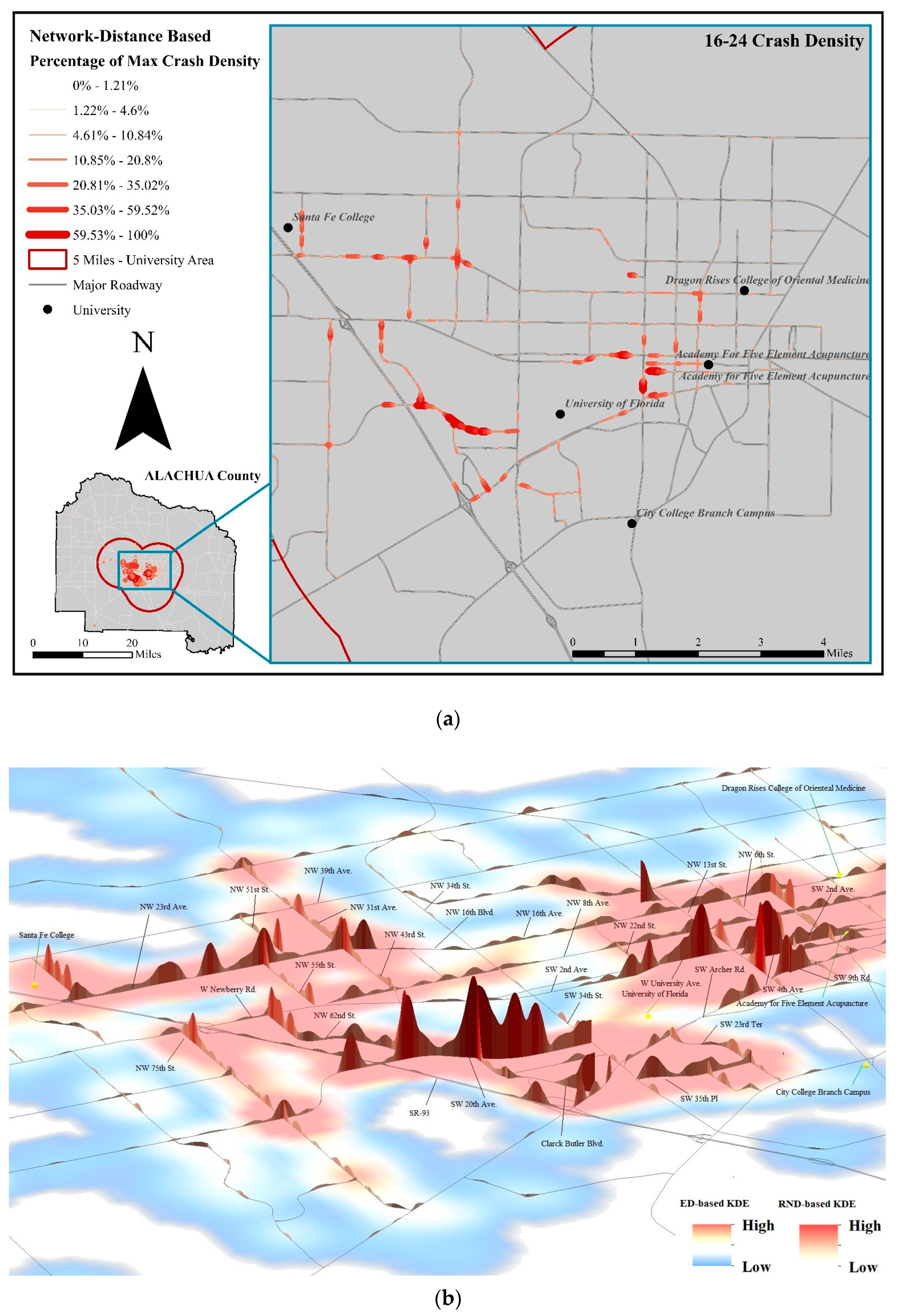
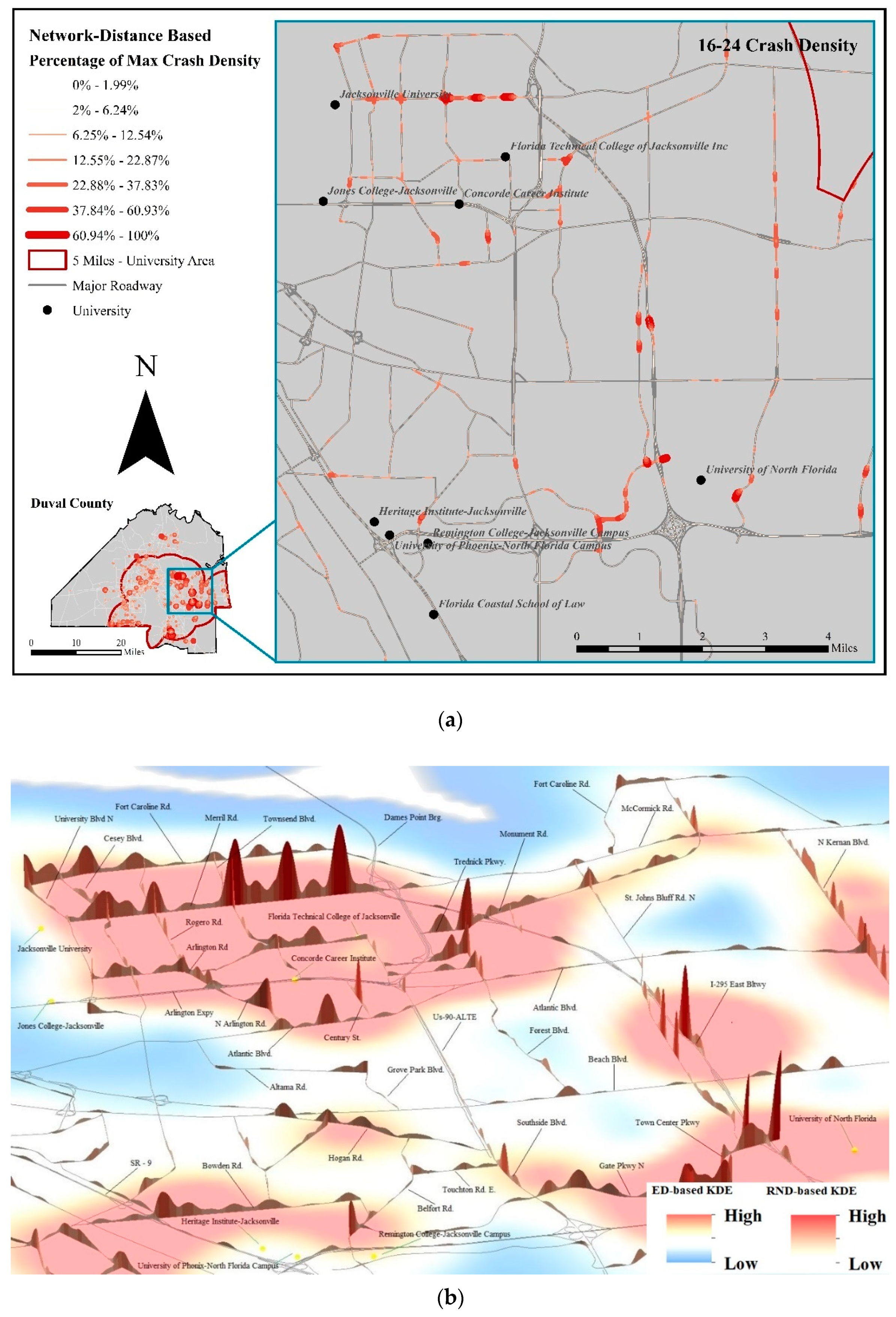
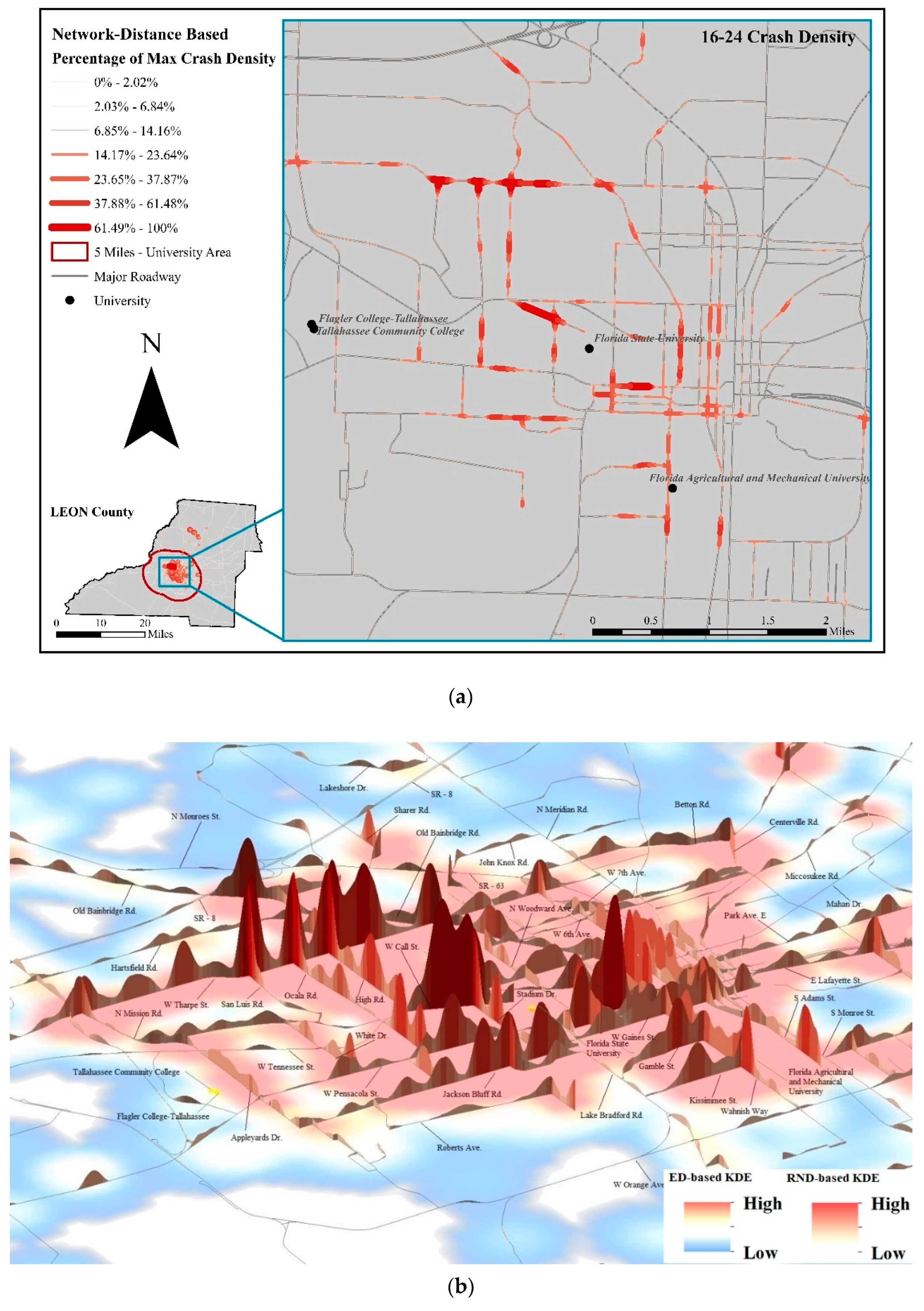
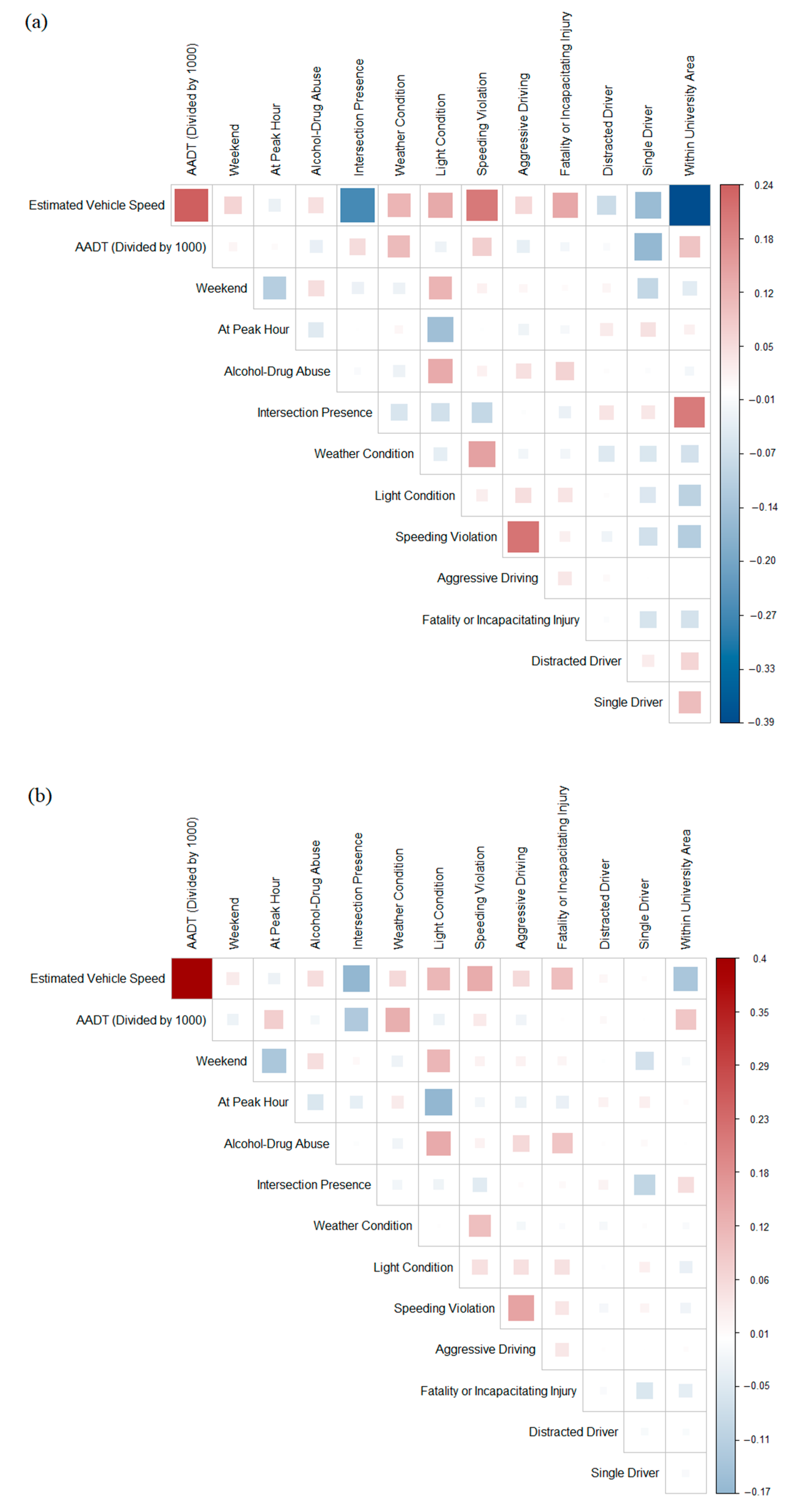
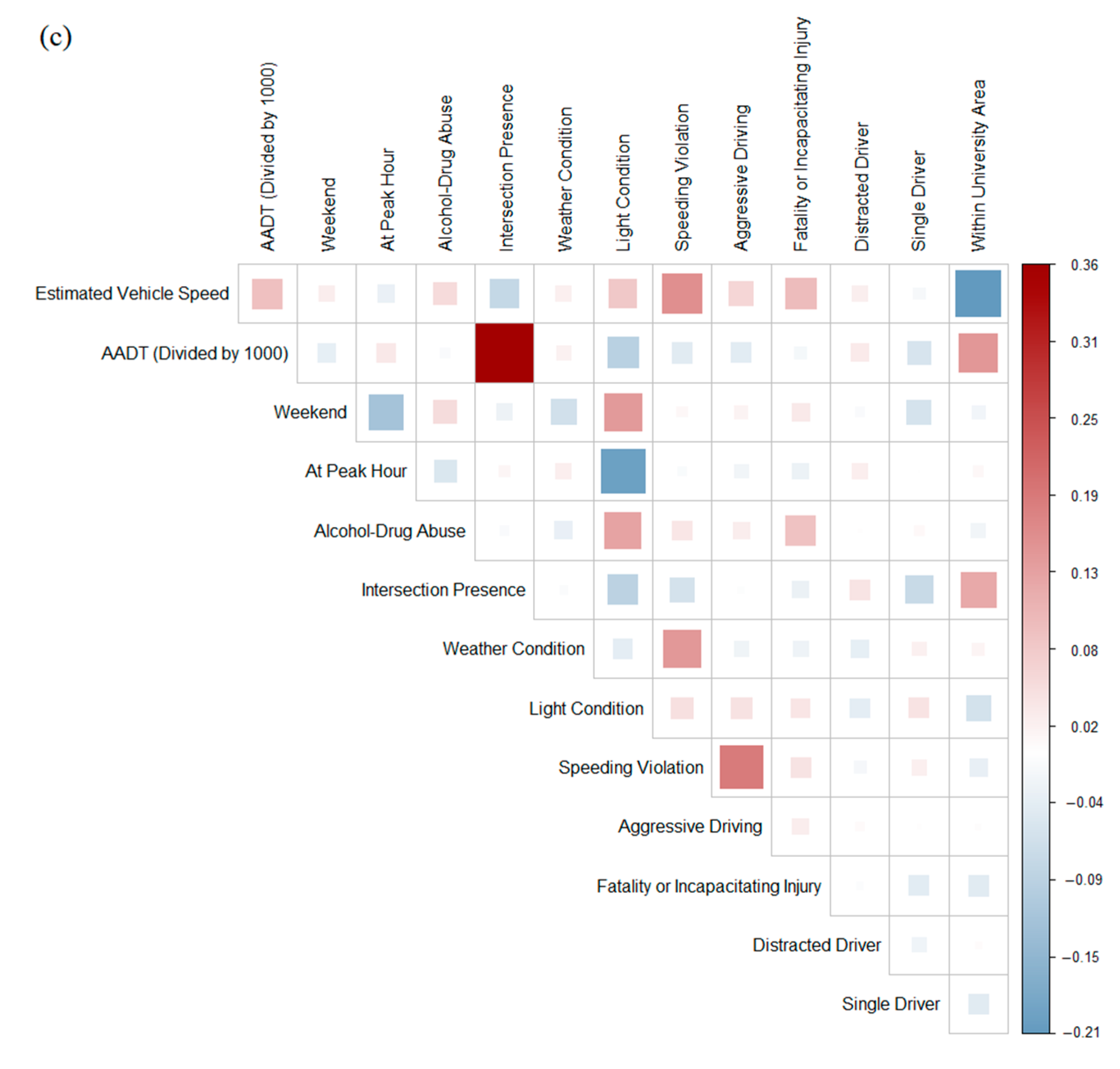
| Predictor Variable | Description |
|---|---|
| Estimated Vehicle Speed (mph) | The vehicle’s speed at the time of the crash |
| AADT (Divided by 1000) | Average Annual Daily Traffic divided by 1000 |
| Weekend | The crash occurred on Friday, Saturday, or Sunday |
| At Peak Hours | The crash occurred during peak hours (6–9 a.m. & 4–7 p.m.) |
| Alcohol-Drug Abuse | One or more drivers were under the influence of alcohol/drugs |
| Intersection Presence | Intersection involvement for the crash |
| Weather Conditions | The crash has not occurred during clear weather conditions |
| Light Conditions | The crash has not occurred during daylight conditions |
| Speeding Violation | Speeding involvement for the crash |
| Aggressive Driving | Aggressive driving by one or more of the drivers |
| Fatality or Incapacitating Injury | Fatality or Incapacitating injury has occurred |
| Distracted Driver | One or more drivers were distracted at the time of the crash |
| Single Driver | Single-Driver crash (No passenger) |
| Within University Area | The crash occurred within a 5-mile buffer around the university |
| Year | ||||||
|---|---|---|---|---|---|---|
| 2011 | 2012 | 2013 | 2014 | Total | ||
| Local Roadway | Florida | 100,220 | 113,514 | 133,605 | 157,229 | 504,568 |
| Alachua | 1340 | 1396 | 1346 | 1255 | 5337 | |
| Duval | 3731 | 7888 | 8827 | 8567 | 29,013 | |
| Leon | 2405 | 2387 | 2611 | 2774 | 10,177 | |
| Highway System | Florida | 145,517 | 169,310 | 194,456 | 214,968 | 724,251 |
| Alachua | 3473 | 3568 | 3812 | 3301 | 14,154 | |
| Duval | 8269 | 16,723 | 17,584 | 17,279 | 59,855 | |
| Leon | 2756 | 2797 | 2934 | 3205 | 11,692 | |
| County | Total Population | Total # of Crashes | Total # of Young-Driver-Involved Crashes (% to Total) | Total # of Young-Driver-Involved Crashes Around the University (% to Young-Driver-Involved Crashes) | Junior Colleges, Colleges, Universities, and Professional Schools | Enrollment |
|---|---|---|---|---|---|---|
| Alachua | 269,000 | 19,491 | 8177 (42%) | 7191 (88%) | University of Florida | 51,475 |
| Santa Fe College | 14,796 | |||||
| Dragon Rises College of Oriental Medicine | 36 | |||||
| City College Branch Campus | 272 | |||||
| Academy for Five Element Acupuncture | 32 | |||||
| Duval | 957,000 | 88,868 | 27,930 (31%) | 24,365 (87%) | University of Phoenix-North Florida Campus | 1126 |
| University of North Florida | 14,982 | |||||
| Trinity Baptist College | 300 | |||||
| Stenotype Institute of Jacksonville Inc. | 293 | |||||
| Remington College—Jacksonville Campus | Online | |||||
| Jones College—Jacksonville | 558 | |||||
| Jacksonville University | 3418 | |||||
| ITT Technical Institute—Jacksonville | 552 | |||||
| Heritage Institute—Jacksonville | 388 | |||||
| Florida Technical College of Jacksonville Inc. | 204 | |||||
| Florida Community College at Jacksonville | 25,686 | |||||
| Florida Coastal School of Law | 1498 | |||||
| Everest University—Jacksonville | 438 | |||||
| Edward Waters College | 840 | |||||
| Concorde Career Institute | 587 | |||||
| Leon | 293,000 | 21,869 | 8833 (40%) | 7166 (81%) | Tallahassee Community College | 14,048 |
| Florida State University | 38,717 | |||||
| Florida Agricultural and Mechanical University | 11,672 | |||||
| Flagler College—Tallahassee | 454 |
| Regressors | Alachua County | Duval County | Leon County | |||||||||
|---|---|---|---|---|---|---|---|---|---|---|---|---|
| β | SE | p | VIF | β | SE | p | VIF | β | SE | p | VIF | |
| Intercept | −1.319 | 0.060 | −0.865 | 0.026 | −0.933 | 0.053 | ||||||
| Estimated Vehicle Speed | 0.005 | 0.001 | 1.41 | 0.016 | 0.001 | 1.13 | ||||||
| AADT/1000 | 0.002 | 0.001 | 0.04 | 1.16 | 0.002 | 0.000 | 1.05 | −0.002 | 0.001 | 0.02 | 1.20 | |
| Weekend | −0.031 | 0.015 | 0.04 | 1.03 | ||||||||
| At Peak Hour | 0.047 | 0.015 | 1.05 | −0.093 | 0.031 | 0.01 | 1.04 | |||||
| Alcohol/Drug Abuse | 0.393 | 0.109 | 1.01 | 0.206 | 0.124 | 0.09 | 1.03 | |||||
| Intersection Presence | 0.185 | 0.031 | 1.10 | 0.115 | 0.015 | 1.04 | 0.199 | 0.031 | 1.18 | |||
| Weather Condition | 0.057 | 0.032 | 0.07 | 1.03 | 0.058 | 0.015 | 1.03 | |||||
| Light Condition | 0.053 | 0.016 | 1.05 | −0.169 | 0.031 | 1.08 | ||||||
| Speeding Violation | 0.373 | 0.050 | 1.04 | 0.532 | 0.070 | 1.07 | ||||||
| Aggressive Driving | −0.748 | 0.168 | 1.01 | 0.179 | 0.085 | 0.03 | 1.03 | −0.238 | 0.120 | 0.05 | 1.04 | |
| Fatality/Incapacitating | −0.215 | 0.073 | 1.03 | −0.114 | 0.039 | 1.01 | −0.331 | 0.083 | 1.02 | |||
| Distracted Driver | 0.387 | 0.039 | 1.01 | 0.351 | 0.021 | 1.00 | 0.477 | 0.040 | 1.00 | |||
| Single Driver | 0.068 | 0.030 | 0.02 | 1.05 | −0.337 | 0.015 | 1.02 | −0.358 | 0.029 | 1.01 | ||
| Within University Area | 0.718 | 0.046 | 1.24 | 0.067 | 0.022 | 0.002 | 1.02 | 0.371 | 0.037 | 1.09 | ||
| N: 19,491, df: 19,480 | N: 88,868, df: 88,855 | N: 21,869, df: 21,856 | ||||||||||
| County | Total # of Crash | Total # of Intersection Involvement Crash | Young-Driver Intersection Crash | Total # of Distracted Driver at Intersection Involvement Crash | Distracted Young Driver at Intersection |
|---|---|---|---|---|---|
| Alachua | 19,491 | 10,305 (53%) | 4623 (45%) | 1937 (10%) | 1015 (52%) |
| Duval | 88,868 | 36,476 (41%) | 12,031 (33%) | 5015 (6%) | 1994 (40%) |
| Leon | 21,869 | 9362 (43%) | 4037 (43%) | 1422 (7%) | 742 (52%) |
| County | Total # of Crash | Youth Involved Crash | Total # of Alcohol/Drug Crash | Young-Driver Alcohol/Drug Crash | Total # of Distracted Driver | Young-Driver Distracted Driver |
|---|---|---|---|---|---|---|
| Alachua | 19,491 | 8177 (42%) | 328 | 147 (45%) | 3366 | 1696 (50%) |
| Duval | 88,868 | 27,930 (31%) | 1350 | 413 (31%) | 11,553 | 4436 (38%) |
| Leon | 21,869 | 8833 (40%) | 290 | 131 (45%) | 2982 | 1522 (51%) |
Publisher’s Note: MDPI stays neutral with regard to jurisdictional claims in published maps and institutional affiliations. |
© 2022 by the authors. Licensee MDPI, Basel, Switzerland. This article is an open access article distributed under the terms and conditions of the Creative Commons Attribution (CC BY) license (https://creativecommons.org/licenses/by/4.0/).
Share and Cite
Koloushani, M.; Ghorbanzadeh, M.; Ulak, M.B.; Ozguven, E.E.; Horner, M.W.; Vanli, O.A. The Analysis of Spatial Patterns and Significant Factors Associated with Young-Driver-Involved Crashes in Florida. Sustainability 2022, 14, 696. https://doi.org/10.3390/su14020696
Koloushani M, Ghorbanzadeh M, Ulak MB, Ozguven EE, Horner MW, Vanli OA. The Analysis of Spatial Patterns and Significant Factors Associated with Young-Driver-Involved Crashes in Florida. Sustainability. 2022; 14(2):696. https://doi.org/10.3390/su14020696
Chicago/Turabian StyleKoloushani, Mohammadreza, Mahyar Ghorbanzadeh, Mehmet Baran Ulak, Eren Erman Ozguven, Mark W. Horner, and Omer Arda Vanli. 2022. "The Analysis of Spatial Patterns and Significant Factors Associated with Young-Driver-Involved Crashes in Florida" Sustainability 14, no. 2: 696. https://doi.org/10.3390/su14020696
APA StyleKoloushani, M., Ghorbanzadeh, M., Ulak, M. B., Ozguven, E. E., Horner, M. W., & Vanli, O. A. (2022). The Analysis of Spatial Patterns and Significant Factors Associated with Young-Driver-Involved Crashes in Florida. Sustainability, 14(2), 696. https://doi.org/10.3390/su14020696








